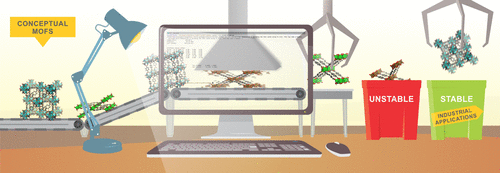当前位置:
X-MOL 学术
›
Acc. Chem. Res.
›
论文详情
Our official English website, www.x-mol.net, welcomes your
feedback! (Note: you will need to create a separate account there.)
Reliably Modeling the Mechanical Stability of Rigid and Flexible Metal-Organic Frameworks.
Accounts of Chemical Research ( IF 16.4 ) Pub Date : 2017-11-20 , DOI: 10.1021/acs.accounts.7b00404 Sven M J Rogge 1 , Michel Waroquier 1 , Veronique Van Speybroeck 1
Accounts of Chemical Research ( IF 16.4 ) Pub Date : 2017-11-20 , DOI: 10.1021/acs.accounts.7b00404 Sven M J Rogge 1 , Michel Waroquier 1 , Veronique Van Speybroeck 1
Affiliation

|
Over the past two decades, metal-organic frameworks (MOFs) have matured from interesting academic peculiarities toward a continuously expanding class of hybrid, nanoporous materials tuned for targeted technological applications such as gas storage and heterogeneous catalysis. These oft-times crystalline materials, composed of inorganic moieties interconnected by organic ligands, can be endowed with desired structural and chemical features by judiciously functionalizing or substituting these building blocks. As a result of this reticular synthesis, MOF research is situated at the intriguing intersection between chemistry and physics, and the building block approach could pave the way toward the construction of an almost infinite number of possible crystalline structures, provided that they exhibit stability under the desired operational conditions. However, this enormous potential is largely untapped to date, as MOFs have not yet found a major breakthrough in technological applications. One of the remaining challenges for this scale-up is the densification of MOF powders, which is generally achieved by subjecting the material to a pressurization step. However, application of an external pressure may substantially alter the chemical and physical properties of the material. A reliable theoretical guidance that can presynthetically identify the most stable materials could help overcome this technological challenge. In this Account, we describe the recent research the progress on computational characterization of the mechanical stability of MOFs. So far, three complementary approaches have been proposed, focusing on different aspects of mechanical stability: (i) the Born stability criteria, (ii) the anisotropy in mechanical moduli such as the Young and shear moduli, and (iii) the pressure-versus-volume equations of state. As these three methods are grounded in distinct computational approaches, it is expected that their accuracy and efficiency will vary. To date, however, it is unclear which set of properties are suited and reliable for a given application, as a comprehensive comparison for a broad variety of MOFs is absent, impeding the widespread use of these theoretical frameworks. Herein, we fill this gap by critically assessing the performance of the three computational models on a broad set of MOFs that are representative for current applications. These materials encompass the mechanically rigid UiO-66(Zr) and MOF-5(Zn) as well as the flexible MIL-47(V) and MIL-53(Al), which undergo pressure-induced phase transitions. It is observed that the Born stability criteria and pressure-versus-volume equations of state give complementary insight into the macroscopic and microscopic origins of instability, respectively. However, interpretation of the Born stability criteria becomes increasingly difficult when less symmetric materials are considered. Moreover, pressure fluctuations during the simulations hamper their accuracy for flexible materials. In contrast, the pressure-versus-volume equations of state are determined in a thermodynamic ensemble specifically targeted to mitigate the effects of these instantaneous fluctuations, yielding more accurate results. The critical Account presented here paves the way toward a solid computational framework for an extensive presynthetic screening of MOFs to select those that are mechanically stable and can be postsynthetically densified before their use in targeted applications.
中文翻译:

可靠地对刚性和柔性金属有机框架的机械稳定性进行建模。
在过去的二十年中,金属有机框架(MOF)已从有趣的学术特性逐渐发展成为针对目标技术应用(例如储气和非均相催化)而不断改进的杂化纳米多孔材料类别。这些经常由有机配体相互连接的由无机部分组成的晶体材料,可以通过明智地功能化或取代这些结构单元而获得所需的结构和化学特征。这种网状合成的结果是,MOF研究位于化学和物理之间有趣的交汇处,并且只要在以下条件下表现出稳定性,构造单元方法就可以为构造几乎无限数量的可能晶体结构铺平道路。所需的操作条件。但是,由于MOF尚未在技术应用中找到重大突破,因此迄今为止尚未挖掘出巨大的潜力。这种放大的剩余挑战之一是MOF粉末的致密化,这通常是通过对材料进行加压步骤来实现的。但是,施加外部压力可能会实质上改变材料的化学和物理性质。可靠的理论指导可以综合识别最稳定的材料,可以帮助克服这一技术挑战。在这个帐户中,我们描述了最近的研究在MOF的机械稳定性的计算表征方面的进展。到目前为止,已经提出了三种互补的方法,着重于机械稳定性的不同方面:(i)Born稳定性标准,(ii)机械模量的各向异性,例如杨氏模量和剪切模量,以及(iii)状态的压力体积比方程。由于这三种方法基于不同的计算方法,因此预计它们的准确性和效率会有所不同。但是,到目前为止,尚不清楚哪一组属性适合于给定的应用程序,因为缺少对各种MOF的全面比较,这妨碍了这些理论框架的广泛使用。在这里,我们通过严格评估代表当前应用程序的广泛MOF上三个计算模型的性能来填补这一空白。这些材料包括机械刚性的UiO-66(Zr)和MOF-5(Zn)以及柔性的MIL-47(V)和MIL-53(Al),它们会经历压力诱导的相变。观察到,Born稳定性标准和状态的压力-体积方程分别提供了对不稳定性的宏观和微观起源的补充见解。但是,当考虑使用不太对称的材料时,解释Born稳定性标准变得越来越困难。此外,模拟过程中的压力波动会影响其对柔性材料的准确性。相反,在专门针对减轻这些瞬时波动的影响的热力学系中确定状态的压力与体积的关系式,从而得出更准确的结果。
更新日期:2017-11-20
中文翻译:

可靠地对刚性和柔性金属有机框架的机械稳定性进行建模。
在过去的二十年中,金属有机框架(MOF)已从有趣的学术特性逐渐发展成为针对目标技术应用(例如储气和非均相催化)而不断改进的杂化纳米多孔材料类别。这些经常由有机配体相互连接的由无机部分组成的晶体材料,可以通过明智地功能化或取代这些结构单元而获得所需的结构和化学特征。这种网状合成的结果是,MOF研究位于化学和物理之间有趣的交汇处,并且只要在以下条件下表现出稳定性,构造单元方法就可以为构造几乎无限数量的可能晶体结构铺平道路。所需的操作条件。但是,由于MOF尚未在技术应用中找到重大突破,因此迄今为止尚未挖掘出巨大的潜力。这种放大的剩余挑战之一是MOF粉末的致密化,这通常是通过对材料进行加压步骤来实现的。但是,施加外部压力可能会实质上改变材料的化学和物理性质。可靠的理论指导可以综合识别最稳定的材料,可以帮助克服这一技术挑战。在这个帐户中,我们描述了最近的研究在MOF的机械稳定性的计算表征方面的进展。到目前为止,已经提出了三种互补的方法,着重于机械稳定性的不同方面:(i)Born稳定性标准,(ii)机械模量的各向异性,例如杨氏模量和剪切模量,以及(iii)状态的压力体积比方程。由于这三种方法基于不同的计算方法,因此预计它们的准确性和效率会有所不同。但是,到目前为止,尚不清楚哪一组属性适合于给定的应用程序,因为缺少对各种MOF的全面比较,这妨碍了这些理论框架的广泛使用。在这里,我们通过严格评估代表当前应用程序的广泛MOF上三个计算模型的性能来填补这一空白。这些材料包括机械刚性的UiO-66(Zr)和MOF-5(Zn)以及柔性的MIL-47(V)和MIL-53(Al),它们会经历压力诱导的相变。观察到,Born稳定性标准和状态的压力-体积方程分别提供了对不稳定性的宏观和微观起源的补充见解。但是,当考虑使用不太对称的材料时,解释Born稳定性标准变得越来越困难。此外,模拟过程中的压力波动会影响其对柔性材料的准确性。相反,在专门针对减轻这些瞬时波动的影响的热力学系中确定状态的压力与体积的关系式,从而得出更准确的结果。











































 京公网安备 11010802027423号
京公网安备 11010802027423号